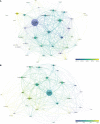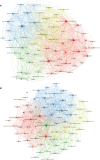Research landscape and trends of melanoma immunotherapy: A bibliometric analysis
- PMID: 36698407
- PMCID: PMC9868470
- DOI: 10.3389/fonc.2022.1024179
Research landscape and trends of melanoma immunotherapy: A bibliometric analysis
Abstract
Background: Immunotherapy for lung cancer has been a hot research area for years. This bibliometric analysis was intended to present research trends on melanoma immunotherapy.
Method: On April 1, 2022, the authors identified 2,109 papers on melanoma immunotherapy using the Web of Science and extracted their general information and the total number of citations. The authors then conducted a bibliometric analysis to present the research landscape, clarify the research trends, and determine the most cited papers (top-papers) as well as major journals on melanoma immunotherapy. Subsequently, recent research hotspots were identified by analyzing the latest articles in major journals.
Results: The total and median number of citations of these 2,109 papers on melanoma immunotherapy was 137,686 and 11, respectively. "Improved survival with ipilimumab in patients with metastatic melanoma" by Hodi et al. was the most cited paper (9,824 citations). Among the journals, the top-paper number (16), average citations per paper (2,510.7), and top-papers rate (100%) of New England Journal of Medicine were the highest. Corresponding authors represented the USA took part in most articles (784). Since 2016, the hottest research area has changed from CTLA-4 to PD-1.
Conclusions: This bibliometric analysis comprehensively and quantitatively presents the research trends and hotspots based on 2,109 relevant publications, and further suggests future research directions. The researchers can benefit in selecting journals and in finding potential collaborators. This study can help researchers gain a comprehensive impression of the research landscape, historical development, and current hotspots in melanoma immunotherapy and can provide inspiration for future research.
Keywords: CTLA-4; PD1/PDL1; adoptive cell therapy; bibliometric analysis; clinical trials; immunotherapy; melanoma; tumor mutation burden.
Copyright © 2023 Liu, Yu, Liang, Cheng, Jiang, Yu, Zhang, Lu, Qu, Chen and Zhang.
Conflict of interest statement
The authors declare that the research was conducted in the absence of any commercial or financial relationships that could be construed as a potential conflict of interest.
Figures









Similar articles
-
Global research landscape and trends of lung cancer immunotherapy: A bibliometric analysis.Front Immunol. 2022 Dec 1;13:1032747. doi: 10.3389/fimmu.2022.1032747. eCollection 2022. Front Immunol. 2022. PMID: 36532038 Free PMC article.
-
Research Trends and Most Influential Clinical Studies on Anti-PD1/PDL1 Immunotherapy for Cancers: A Bibliometric Analysis.Front Immunol. 2022 Apr 11;13:862084. doi: 10.3389/fimmu.2022.862084. eCollection 2022. Front Immunol. 2022. PMID: 35493449 Free PMC article.
-
Research landscape and trends of lung cancer radiotherapy: A bibliometric analysis.Front Oncol. 2022 Nov 10;12:1066557. doi: 10.3389/fonc.2022.1066557. eCollection 2022. Front Oncol. 2022. PMID: 36439443 Free PMC article.
-
Immunotherapy for ocular melanoma: a bibliometric and visualization analysis from 1991 to 2022.Front Oncol. 2023 May 31;13:1161759. doi: 10.3389/fonc.2023.1161759. eCollection 2023. Front Oncol. 2023. PMID: 37324010 Free PMC article.
-
Research Hotspots and Trends of Peripheral Nerve Injuries Based on Web of Science From 2017 to 2021: A Bibliometric Analysis.Front Neurol. 2022 May 20;13:872261. doi: 10.3389/fneur.2022.872261. eCollection 2022. Front Neurol. 2022. PMID: 35669875 Free PMC article.
Cited by
-
Global research landscape and trends of cancer radiotherapy plus immunotherapy: A bibliometric analysis.Heliyon. 2024 Feb 27;10(5):e27103. doi: 10.1016/j.heliyon.2024.e27103. eCollection 2024 Mar 15. Heliyon. 2024. PMID: 38449655 Free PMC article.
-
Interpretation of the past, present, and future of organoid technology: an updated bibliometric analysis from 2009 to 2024.Front Cell Dev Biol. 2024 Aug 13;12:1433111. doi: 10.3389/fcell.2024.1433111. eCollection 2024. Front Cell Dev Biol. 2024. PMID: 39193361 Free PMC article.
-
Research hotspots and frontiers in acral melanoma: A bibliometric analysis from 1999 to 2023.Heliyon. 2023 Dec 19;10(1):e23720. doi: 10.1016/j.heliyon.2023.e23720. eCollection 2024 Jan 15. Heliyon. 2023. PMID: 38226247 Free PMC article.
-
Dual immunotherapy in advanced or metastatic non-small cell lung cancer: A network meta-analysis.Heliyon. 2024 Mar 2;10(5):e27576. doi: 10.1016/j.heliyon.2024.e27576. eCollection 2024 Mar 15. Heliyon. 2024. PMID: 38463838 Free PMC article.
-
Global research landscape and trends of cancer stem cells from 1997 to 2023: A bibliometric analysis.Medicine (Baltimore). 2024 May 17;103(20):e38125. doi: 10.1097/MD.0000000000038125. Medicine (Baltimore). 2024. PMID: 38758889 Free PMC article.
References
-
- Keilholz U, Martus P, Punt CJ, Kruit W, Mooser G, Schadendorf D, et al. Prognostic factors for survival and factors associated with long-term remission in patients with advanced melanoma receiving cytokine-based treatments: second analysis of a randomised EORTC melanoma group trial comparing interferon-alpha2a (IFNalpha) and interleukin 2 (IL-2) with or without cisplatin. Eur J Cancer (2002) 38:1501–11. doi: 10.1016/s0959-8049(02)00123-5 - DOI - PubMed
-
- Rosenberg SA, Yang JC, Topalian SL, Schwartzentruber DJ, Weber JS, Parkinson DR, et al. Treatment of 283 consecutive patients with metastatic melanoma or renal cell cancer using high-dose bolus interleukin 2. JAMA (1994) 271:907–13. - PubMed
LinkOut - more resources
Full Text Sources
Research Materials
Miscellaneous

